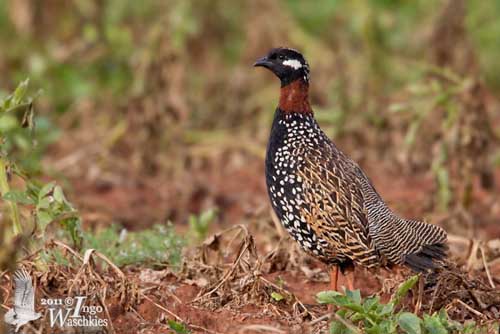
Fr: Francolin noir
All : Halsbandfrankolin
Esp : Francolín Ventrinegro
Ital: Francolino a petto nero
Nd: Zwarte Frankolijn
Sd: Svart frankolin
Photographers:
Niraj V. Mistry
Photo Galleries
Ingo Waschkies
My bird pictures on Pbase
Texte de Nicole Bouglouan
Sources:
HANDBOOK OF THE BIRDS OF THE WORLD Vol 2 by Josep del Hoyo-Andrew Elliot-Jordi Sargatal - Lynx Edicions - ISBN: 8487334156
BIRDS OF THE MIDDLE EAST by R.F. Porter, S. Christensen, P Schiermacker-Ansen C.Helm - ISBN: 0713670169
Hennache, A. & Ottaviani, M. (2011). Cailles, Perdrix et Francolins de l'Ancien Monde, 400 pages. Editions W.P.A. France, Clères, France. ISBN 978-2-9512467-3-7
Hennache, A. & Ottaviani, M. (2005). Monographie des faisans, volume 1. Edition W.P.A. France, Clères, France. ISBN: 2-9512467-1-4
Hennache, A. & Ottaviani, M. (2006). Monographie des faisans, volume 2. Edition W.P.A. France, Clères, France.ISBN: 2-9512467-2-2
"Les auteurs renoncent à leurs droits d'auteurs pour que la vente de cet ouvrage, publié par la World Pheasant Association, soit destinée à soutenir des projets de conservation."
BirdLife International (BirdLife International)
What Bird-The ultimate Bird Guide (Mitchell Waite)
Wikipedia, the free encyclopaedia
XENO-CANTO – Sharing Birds sounds from around the world
Black Francolin
Francolinus francolinus
Galliforme Order – Phasianidae Family
BIOMETRICS:
Length: 33-36 cm
Wingspan: 50-55 cm
Weigh: M: 482 g – F: 424 g
DESCRIPTION:
This beautiful Phasianidae is a famous gamebird, heavily hunted and trapped until the recent years, involving large decrease of populations. But now, with better control of hunting pressure in several regions, the Black Francolin is gradually recovering better numbers.
The adult male has buffy-brown upperparts with brown back and wings. Feathers are edged pale buff, giving scaled effect. Rump, uppertail-coverts and tail are black narrowly barred white.
On the underparts, throat and breast are black. Belly and undertail-coverts are chestnut. Upper mantle, body sides and flanks are black, with conspicuous white-edged feathers, giving heavy spotted effect.

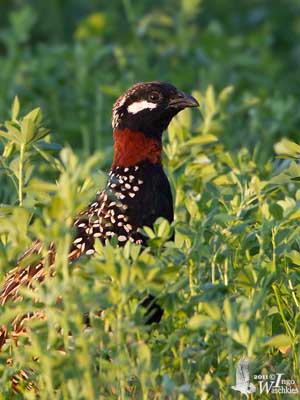
The head is black with white patch on the rear of the cheeks. The neck shows complete chestnut collar.
The strong bill is black. The eyes are dark brown. Legs and feet are reddish-brown, with short spur on the rear leg.
The female is paler, mainly brown with chestnut hindneck. The upperparts are dark brown with pale-edged feathers. Rump, uppertail-coverts and tail are dark brown, finely barred creamy-white.
The underparts are paler, with conspicuous white-edged feathers and barred undertail-coverts.
On the head, crown and nape are brown finely streaked blackish. Face and broad eyebrow are buffy-white. We can see a narrow dark malar stripe. The chin is creamy-white.
The bare parts are similar to those of male, but she lacks the spurs.
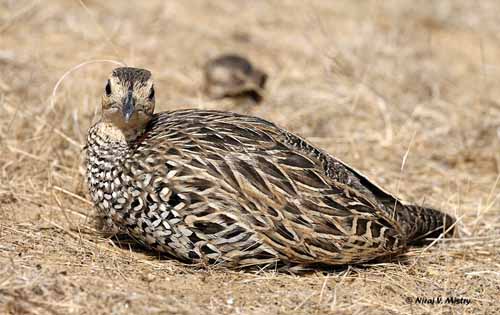
The juvenile resembles female with less marked plumage.
There are six subspecies which differ in size and general tone of plumage coloration. The race “bogdanovi” is palest.
VOICE: SOUNDS BY XENO-CANTO
The Black Francolin is more vocal during the breeding season, but outside this period, it can be heard mainly in the morning and the evening. The loud, penetrating, ringing call is given by the male from a low perch, rock, termite mound or low branch “cheek-cheek-cheerakik”. Other birds join him very soon from several directions in response to this advertising call. We can also hear a mechanical “kik-kik-kik”.
HABITAT:
The Black Francolin frequents the cultivated areas which provide shelter, and more open country for escape. They inhabit several types of well-watered habitats such as brush land, wood edges, grassy areas, but also cultivations along canals and watercourses, and irrigated plantations. This species can be locally seen up to 2500 metres of elevation.
RANGE:
The Black Francolin occurs from Kashmir, Cyprus and SE Turkey, Iran, SW Turkmenistan and NE India. There are some fragmented populations in the western parts of the range.
BEHAVIOUR:
The Black Francolin feeds on plant matter such as seeds of grasses and cereal crops, shoots, leaves, tubers, berries and figs. It may take some insects and their larvae, especially termites.
It forages on the ground or from low bushes and low tree branches.
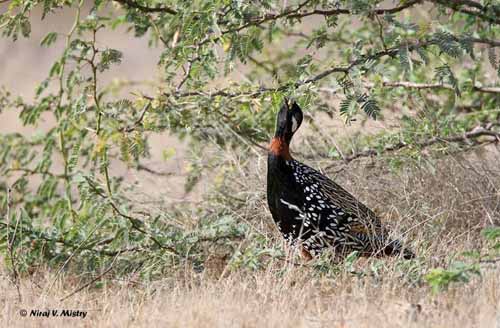
As numerous Phasianidae species, the Black Francolin is terrestrial and prefers to run rather than to fly if disturbed. It flushes from the tall ground cover while calling loudly, performs short flight with rapid wing-beats, before to land rapidly in the nearby cover.
The breeding season starts with the loud creaking calls of the male, given from rock or low tree. It usually becomes aggressive during this period.
The species is sedentary in its range.
FLIGHT:
As the terrestrial birds, the Black Francolin does not like to fly. But is disturbed, it runs or flushes, flying over 300-400 metres in low flight with strong wing-beats alternating with glides, before to run again for reaching the cover.
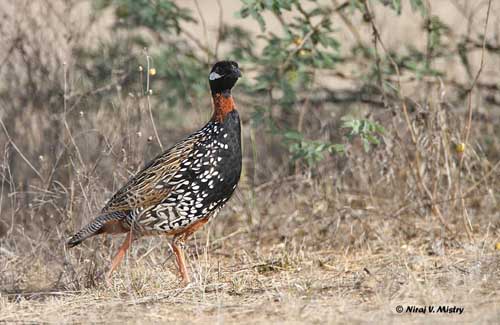
REPRODUCTION:
The breeding season varies according to the range, but it is associated to the rains. This species is monogamous.
The Black Francolin nests on the ground. The female makes a shallow scrape, concealed amongst the vegetation, in tall grasses or cultivated areas. The cup is lined with grasses, twigs and leaves.
She lays 7-12 eggs and incubates alone during about 18-21 days. The downy chicks are pale buff with rufous crown and dark median streak on back.
Both parents rear them after hatching, and the young remain in the family group for some months. This species produces two clutches per season.
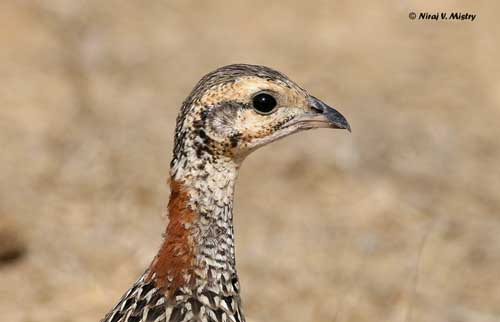
DIET:
The Black Francolin feeds on seeds of grasses, weed and cereal crops. It also takes shoots, leaves and tubers, berries and figs. Some insects and their larvae, and especially termites and ants, are also consumed. It feeds on the ground and occasionally catches amphibians, reptiles, earthworms and spiders.
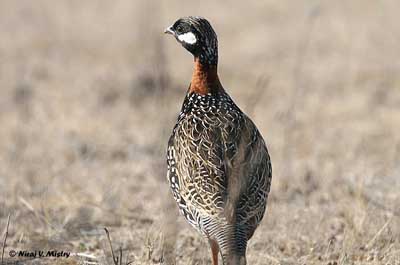
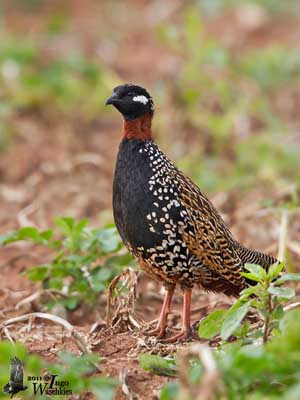
PROTECTION/THREATS/ STATUS:
The Black Francolin has suffered heavy decline due to trapping and overhunting. The species is also vulnerable to habitat loss.
With the ban of hunting, the populations are slowly recovering, but the species is rare in some parts of the range, and common to widespread elsewhere.
However, the populations of the Black Francolin are not currently threatened.